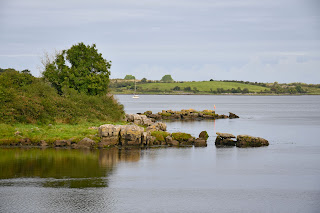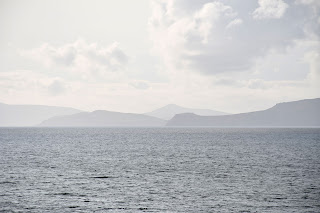Ireland: Day 4 – Driving along the Western Coast
In the morning, I drove the short distance from my accommodation to Dunguaire Castle, which rises above the sea by the village of Kinvarra. Learning from yesterday’s experience, I left the car by the side of the road rather than in the parking lot (though I am still not sure whether the latter charges a fee). I did not spend much time at the castle though. Since it was still closed, I walked along the road taking pictures before I decided to leave again.
Yesterday’s drive left
my gas running quite low, so I made sure to search for a gas station where I
could stop by in the morning. Luckily, there was one right in Kinvarra. Once I
had refuelled, I continued westward to Corcomroe Abbey – another ruined
structure whose community had disbanded by the time Henry VIII dissolved the
monasteries. I found the last section of the drive quite interesting. Once I
left the main road, the paths I followed were very rural, and I even had to
stop for farmers herding cows from one opened gate to another.
Rising steadily from
the abbey, the landscape around me changed from green valleys to rocky cliffs
that stretched as far as the eye could see. At the top of one such rocky cliff
I found my next destination: the Poulnabrone Dolmen. Built on a karst field some
six thousand years ago, the dolmen predates even the ancient structures of Brú
na Bóinne in the east. It was the site of several burials, which occurred
between the years 3800 and 1400 BCE. The weather was showing signs of clearing
up, and the sun occasionally illuminated the ancient stones to great effect.
I reached the
westernmost point of today’s journey at the Cliffs of Moher, which tower as
high as a hundred and fifty metres above the sea. I knew that the cliffs are
among Ireland’s most visited sites, but I was still quite shocked when I was
ushered into a massive and quickly filling parking lot, and when, walking
towards the cliffs, I found numerous spiffy stores flanking the path. The
entire area was swarmed by tourists. I would add the qualification “from all
over the world,” but despite the presence of a few Mandarin-speakers, the vast
majority of the accents I heard had a distinctively nasal American tinge.
From the Cliffs of
Moher, I turned the car southeast and drove to Limerick. After walking along
the river and eating lunch, I visited King John’s Castle, named after the
infamous King John, who subjugated Ireland and forced its population to accept
English Law. However, a significant portion of the exhibition was dedicated to
the two sieges of Limerick, which seem to be a focal point of Irish national
pride. During the first, the vastly outnumbered Jacobite troops were able to
defend themselves against the Englis Williamites, even accepting the aid of
women in pummelling their opponents from the castle walls. The resistance did
not last, however, and the city was allowed to surrender on favourable terms in
1691 when confronted with a second, much more destructive siege. 10,000 men and
4,000 women and children were subsequently allowed to emigrate to France, which
has since been termed “the Flight of the Wild Geese.” The aftermath of the
siege was an even tighter English control over political and public life in
Ireland.
My trip from Limerick
to my accommodation in Portmagee was to take three hours, so I decided to break
it up with a stop at a supermarket two thirds of the way. After I left with my
provisions of bread, cheese, and bananas, I turned on the radio to find that my
favourite presenter on RTE Lyric, Lorcan Murray, has gone on holiday. I have
become quite a fan of the station, which has a good balance of mainstream
content to relatively obscure finds. I am glad, for example, that it introduced
me to the works of Florence Price and the Irish composer Bill Whelan. Perhaps
this is why I have developed a practically Pavlovian response to hearing the
voice of Murray and his colleague Liz Nolan.
As I drove on, I
started thinking about the Irish sceneries I had seen so far. Visitors often rhapsodise
on the beauty of the Emerald Isle, but I could not help thinking that they must
have never visited Great Britain properly. It was then that the sun burst through the
clouds and beautiful mountains emerged to the southwest. I soon found a place
to pull over from which I could photograph a particularly scenic river under
their peaks.
The landscape only
became more beautiful from there. Driving along the coast, I saw hills rising
above the sea in several layers, with their blue-green palette warmed by a
profuse helping of yellow beaches. Impulsively, I decided to hang a right
towards Rossbeigh, hoping that I might get closer to the sea and be able to
properly view the mountains. What I found exceeded my expectations. I arrived
at a long peninsula flanked by sandy beaches on both sides and holding huge grass-covered
dunes in the middle. Numerous groups of people were relaxing and bathing
against the shadow of the western mountains on the sun-facing beach. The
eastern beach was calmer and offered less dramatic views.
Unable to decide
between the two, I decided to explore the middle, and spent a good half an hour
clambering up and down the towering dunes along little paths made by previous
visitors. Oftentimes, the paths would transform into trails in the sand, which
began to slide under my feet as soon as I stepped on them. I found out that the
best way to climb down a dune is to simply make a mad run for it while hoping
that sand and shoe do not end up in fateful union.
I later learned that the
beach I saw to the north was another peninsula: the two face off across the
bay, Rossbeigh Strand from the south, and Inch Beach from the north. Meanwhile,
the hills I had found so beautiful belonged to the Dingle Peninsula, from which
Inch Beach protrudes into the sea. As I rode off, I ascended steeper mountains
towards the west and watched the beautiful Rossbeigh Strand shrink in my
rearview mirror.
Only with today’s drive have I begun to fully appreciate Ireland’s beautiful and diverse scenery. Making my way up the hill, I saw the long grass make room for huge ferns, which both subsided in favour of teeming, jungle-like forests. Occasionally, a pine grove would spring up, while at other times the road was lined with shrubs of orange flowers or tall bushes speckled with red. A little farther inland, a ray of sunshine spilled onto the side of a mountain, illuminating its vast purple expanse of heather.















































Comments
Post a Comment